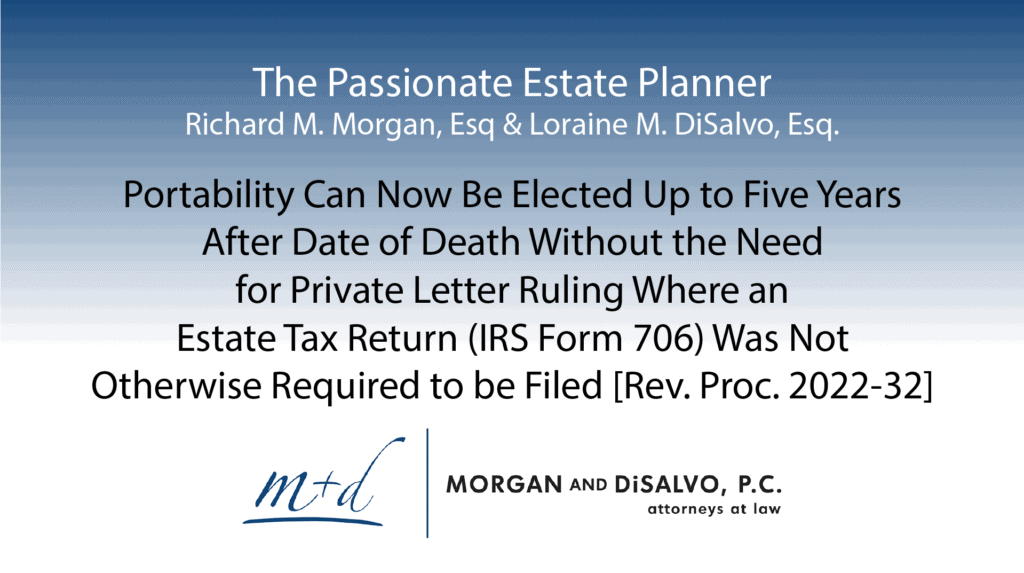The Internal Revenue Service (IRS) has provided good news to many families by effectively extending the time to file an IRS Form 706 and make the portability election to carry over a deceased person’s unused estate tax exemption to a surviving spouse from two years to five years after the first spouse’s date of death (DOD) where the IRS Form 706 was not otherwise required to be filed for the deceased person’s estate.
Situation: Before 2011, if a married person wanted to benefit the person’s spouse at the person’s death while also ensuring that the person’s estate tax exemption (now known as the Basic Exclusion Amount or BEA) could be used, the person had to pass assets to the person’s surviving spouse in a specialized type of trust, generally known as a credit shelter or bypass trust, instead of outright. The estate tax exemption, in other words, was a use it or lose it tax benefit. In 2011, a new election was introduced to the estate tax world. This election, generally referred to as the portability election, allows the surviving spouse of a deceased US citizen or US resident to effectively take over the deceased person’s remaining BEA, allowing that BEA to be preserved for later use even without the use of a credit shelter trust at the deceased person’s death. The availability of the portability election, when combined with the relatively high BEA values, has allowed many, many married couples to simplify their estate plans and provide for an outright distribution of assets from the first spouse to die to the surviving spouse, while still allowing them to use both of their BEAs to reduce their estate tax exposures. For a full discussion of this topic, please see our June 2017, News Alert.
Issue: To make the portability election, the Executor of the deceased person’s estate must file a timely estate tax return for the deceased person’s estate, using IRS Form 706. This requirement for a timely filed estate tax return applies even if the value of the estate, as measured for estate tax purposes, is worth less than the value of the person’s remaining BEA (which is equal to the value of the standard BEA for the year of death, minus the value of the person’s lifetime adjusted taxable gifts). IRS Form 706 has strict and narrow filing deadlines: the initial due date is nine months after the date of death, with a single 6-month extension that is only available if it is requested before the initial nine-month due date has passed. In addition, the IRS Form 706, even with the purportedly simpler reporting requirements provided for estates that are filing only to make the portability election, requires the Executor to gather and provide a great deal of information about the estate’s assets, and it can be time-consuming and costly to prepare. For these reasons, many surviving spouses failed to take advantage of the opportunity to make the portability election by filing timely estate tax returns.
The IRS has some ability to provide relief for surviving spouses in cases where the estate was not otherwise required to file an IRS Form 706 and the only reason to file would have been to make the portability election. One option was for those taxpayers to request a Private Letter Ruling (PLR) to ask for this relief. However, PLR requests are expensive and time consuming for all involved, and the IRS wished to make relief somewhat easier for everyone, so it issued Revenue Procedure 2017-34 to allow an easier method of obtaining relief for failure to make the election on a timely filed IRS Form 706. Under Revenue Procedure 2017-34, a portability election could still be made on a late-filed estate tax return IF (A) the estate was not otherwise required to file an IRS Form 706, and (B) an IRS Form 706 that bore an appropriate notation at the top of the first page was filed for the estate no later than two years after the date of death. Unfortunately for the IRS, the relief option provided by Revenue Procedure 2017-34 has not prevented the IRS from being inundated with PLR requests from estates who failed to make a timely portability election. It appears that many of these requests are being made on behalf of estates that would not have otherwise been required to file an IRS Form 706, and that many of them are being made for periods within five years after the decedent’s death.
What is new? The IRS has now issued Revenue Procedure 2022-32, effective July 8, 2022. Under this new Revenue Procedure, certain estates effectively get even more time to use the simplified relief procedure and make the portability election on a late estate tax return without requesting a private letter ruling. An estate that meets certain requirements now has five years after death, instead of two, to file an IRS Form 706 and make the portability election. Here are the requirements that must be met for relief under Revenue Procedure 2022-32 to be available:
- The decedent was survived by a spouse.
- The decedent died after December 31, 2010.
- The decedent was a citizen or resident of the US on the date of death.
- The Executor was not otherwise required to file an IRS Form 706 based on the value of the gross estate and prior adjusted taxable gifts.
- The Executor did not previously file the IRS Form 706 for the estate.
- The top of the late-filed IRS Form 706 must state that the return is “FILED PURSUANT TO REV. PROC. 2022-32 TO ELECT PORTABILITY UNDER SECTION 2010(c)(5)(a).”
Should married couples pass their assets outright to the surviving spouse and rely on portability? Many of our clients now elect to have assets pass outright from the first spouse to the surviving spouse, simplifying their estate planning. These clients plan to rely on the ability to make a portability election after the first spouse’s death if it appears that both BEAs will be needed to avoid or reduce estate taxes in the future. This is a good option for many couples. Of course, there can still be significant reasons for couples to pass their assets to the surviving spouse primarily in trust, including:
1. Estate Tax and GST Tax Planning. The exemption from the Generation Skipping Transfer (GST) tax is not portable. The only way to preserve the benefits of the GST tax exemption is to use it, either on direct transfers to grandchildren or other lower-generation beneficiaries or to allocate it to trusts that may benefit both a surviving spouse and children as well as lower generations. As a result, wealthier couples who plan to use long-term or dynasty trust planning to benefit their descendants, and who therefore need to maximize the use of both GST tax exemptions, should still consider using planning that involves having assets pass to the surviving spouse in trust, instead of outright, at the first spouse’s death.
For very wealthy clients, using a traditional credit shelter trust as part of their planning can also help maximize the use of both spouses’ BEAs, and may be useful or necessary to reduce the impact of estate taxes in the future. When a BEA is transferred to a surviving spouse under a portability election, the value of the ported BEA is frozen in time- it no longer adjusts to reflect inflation. When a BEA is used to fund a traditional credit shelter trust, which is not included in the surviving spouse’s estate for estate tax purposes, however, the value of the BEA used to fund the trust at the first spouse’s death effectively increases as the value of the assets in the trust increase. This can help maximize the benefits of the first spouse’s BEA by allowing it to grow as the assets grow.
Having the first spouse’s BEA used to fund a trust for the surviving spouse, instead of only using the portability election, can also help lock in the benefits of that BEA and ensure that the first spouse’s BEA will remain available and can be used even if the surviving spouse remarries. BEA that is ported to a surviving spouse and that the surviving spouse has not used to make taxable gifts during that spouse’s lifetime will be lost if the surviving spouse remarries and the new spouse later dies before the surviving spouse dies. BEA that has been used to fund a trust created by the first spouse will not be lost, however, no matter how many times the surviving spouse might remarry and survive new spouses, and even if the surviving spouse makes no lifetime taxable gifts.
Please note: any time assets pass to a surviving spouse in trust, instead of outright, there are other tax effects that exist and that are not discussed here. These other tax effects, including the step-up in income tax basis and income taxation on a trust’s income, should always be considered along with the potential tax benefits of having assets pass to a surviving spouse in trust.
2. Control. If the first spouse to die passes assets to the surviving spouse in trust, instead of outright, the first spouse will effectively retain some level of control over those assets, especially with regard to what happens to the remaining trust assets after the surviving spouse’s death. This is often an important consideration for blended families, where either or both of the spouses have one or more children from prior relationships.
3. Asset protection. Passing assets to the surviving spouse in trust can allow those assets to be protected from unwanted outsiders, including creditors, a subsequent spouse if the surviving spouse ever remarries, and predators who might try to take advantage of the surviving spouse.
For more information on how married couples should pass their assets to the surviving spouse at the first of their deaths, see our January 2022 Newsletter here.
If a married couple decides to structure their estate plan to pass their assets to the surviving spouse outright, should the Executor of the first spouse’s estate go through the trouble of filing the IRS Form 706 to elect portability?
The answer is yes if any realistic chance exists that the first spouse’s BEA may be needed to reduce or avoid estate tax at the surviving spouse’s death. We recommend that this analysis be done on a conservative basis since the tax laws are constantly changing (ex., the BEA is being cut in half on January 1, 2026 under current law and it could even be lowered beyond this level in the future under new laws) and asset values can increase significantly over time because of inflation or excellent investment returns. Many married couples may never need to use both spouses’ BEAs, but even if it appears unlikely that estate taxes will ever be a concern at the date of the first spouse’s death, there are few real downsides to filing the estate tax return and making the election.
That said, many people will still initially decide not to file estate tax returns for estates where the IRS Form 706 is not absolutely required. The good news for those people is that they now effectively have up to five years to change their minds, file the required IRS Forms 706, and make those portability elections without having to first spend huge amounts of time and money to make a private letter ruling request to get relief.
If you would like to learn more about this important and timely topic, please call our offices at (678) 720-0750 or e-mail us at info@morgandisalvo.com to schedule an estate planning consultation to discuss your particular situation.



